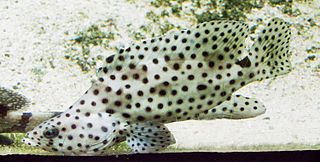
Serranidae is a large family of fishes belonging to the order Perciformes. The family contains about 450 species in 65 genera, including the sea basses and the groupers. Although many species are small, in some cases less than 10 cm (3.9 in), the giant grouper is one of the largest bony fishes in the world, growing to 2.7 m in length and 400 kg (880 lb) in weight. Representatives of this group live in tropical and subtropical seas worldwide.
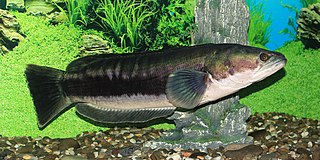
Channa is a genus of predatory fish in the family Channidae, commonly known as snakeheads, native to freshwater habitats in Asia. This genus contains about 50 scientifically described species. The genus has a wide natural distribution extending from Iraq in the west, to Indonesia and China in the east, and parts of Siberia in the Far East. A particularly high richness of species exists in Myanmar (Burma) and northeastern India, and many Channa species live nowhere else. In contrast, a few widespread species have been introduced to several regions outside their natural range, where they often become invasive. The large and medium-sized Channa species are among the most common staple food fish in several Asian countries, and they are extensively cultured. Apart from their importance as a food fish, snakeheads are consumed in some regions as a traditional medicine for wound healing and reducing postoperative pain and discomfort, and collected for the international aquarium pet trade.
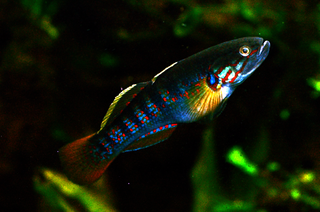
Eleotridae is a family of fish commonly known as sleeper gobies, with about 34 genera and 180 species. Most species are found in the tropical Indo-Pacific region, but there are also species in subtropical and temperate regions, warmer parts of the Americas and near the Atlantic coast in Africa. While many eleotrids pass through a planktonic stage in the sea and some spend their entire lives in the sea; as adults, the majority live in freshwater streams and brackish water. One of its genera, Caecieleotris, is troglobitic. They are especially important as predators in the freshwater stream ecosystems on oceanic islands such as New Zealand and Hawaii that otherwise lack the predatory fish families typical of nearby continents, such as catfish. Anatomically, they are similar to the gobies (Gobiidae), though unlike the majority of gobies, they do not have a pelvic sucker.

Rasbora is a genus of fish in the family Cyprinidae. They are native to freshwater habitats in South and Southeast Asia, as well as southeast China. A single species, R. gerlachi, is only known from an old specimen that reputedly originated from Africa (Cameroon), but this locality is considered doubtful. They are small, up to 17 cm (6.7 in) long, although most species do not surpass 10 cm (4 in) and many have a dark horizontal stripe.

The superorder Elopomorpha contains a variety of types of fishes that range from typical silvery-colored species, such as the tarpons and ladyfishes of the Elopiformes and the bonefishes of the Albuliformes, to the long and slender, smooth-bodied eels of the Anguilliformes. The one characteristic uniting this group of fishes is they all have leptocephalus larvae, which are unique to the Elopomorpha. No other fishes have this type of larvae.

Labeo is a genus of carps in the family Cyprinidae. They are found in freshwater habitats in the tropics and subtropics of Africa and Asia.

Hemirhamphodon is a genus of viviparous halfbeak fish. Most recognized species are endemic to lowland forest streams, rivers and swamps in Borneo, but H. phaiosoma and H. pogonognathus are also found elsewhere in Southeast Asia. The largest species reaches about 10 cm (4 in) in length. These fish are viviparous and are sometimes kept as aquarium fish, but otherwise have no commercial value.

Laetacara is a small genus of cichlids native to freshwater habitats in tropical and subtropical South America, ranging from the upper Orinoco River basin in Venezuela to the Paraná River basin Argentina. The genus is also collectively known as the smiling acaras. Like all cichlids, Laetacara species have well-developed brood care.

Bathygobius is a circumtropical genus of fish in the family Gobiidae.
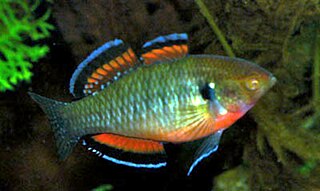
Hypseleotris is a genus of fishes in the family Eleotridae. Most are from fresh water in Australia and New Guinea, but species in fresh and brackish water are found around islands in the western Indian Ocean, southern and eastern Africa, southern and eastern Asia, and Pacific islands. The largest species reaches a length of 12 cm (4.7 in). They are sometimes seen in the aquarium trade; especially H. compressa. In Australia they are known as carp gudgeons.
Lentipes is a genus of gobies native to fresh, marine and brackish waters of the Malay Archipelago and islands in the Pacific. Its species are typically from fast-flowing streams and some are anadromous.

Oxyeleotris is a genus of sleeper gobies mostly restricted to Australia and New Guinea, though some are found in Southeast Asia.

Stenogobius is a genus of fish in the goby subfamily, Gobionellinae. They are native to fresh, brackish and marine waters along the coasts of the Indian and Pacific Oceans. They are known commonly as coastal stream gobies.

Halichoeres are a genus of wrasses found in the Atlantic, Indian and Pacific Oceans.

Dormitator is a genus of fishes in the family Eleotridae mostly found in marine, fresh and brackish waters on either side of the Atlantic Ocean, with one species occurring along the Pacific coast of the Americas.

The dusky sleeper or brown spinecheek gudgeon is a species of fish in the family Eleotridae found in many Indo-West Pacific regions, from the coast of eastern Africa to Hawaii, where it can be found in lagoons, estuaries, and freshwater streams with muddy bottoms.
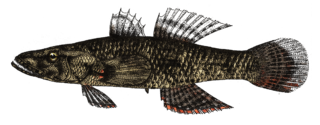
Butidae is a family of sleeper gobies in the order Gobiiformes. The family was formerly classified as a subfamily of the Eleotridae but the 5th Edition of Fishes of the World classifies it as a family in its own right. Molecular phylogenetic analyses have demonstrated that the Butidae are a sister clade to the clade containing the families Gobiidae and Gobionellidae and that the Eleotridae is a sister to both of these clades. This means that the Eloetridae as formerly classified was paraphyletic and that its subfamilies should be raised to the status of families.
Belobranchus segura is a species of eleotrid sleeper goby which has been found in Indonesia on Halmahera, in Papua Barat and also on the Solomon Islands. It is an anadromous species in which the eggs are laid over rocky and gravel bottoms in freshwater streams. The free-swimming larvae then drift downstream to the sea where they undergo a planktonic stage before migrating up streams to mature and breed. It feeds on small crustaceans and fish. The specific name honours the French hydrobiologist Gilles Segura for his contribution to the study of fish faunas.
















